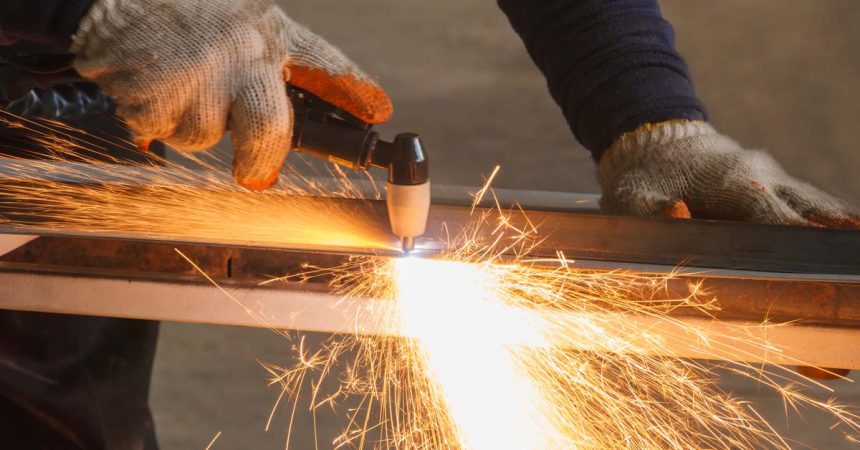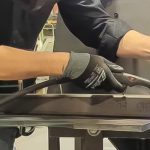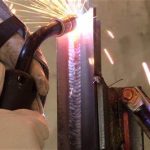When electrically conductive materials need to be cut, gouged, or marked, plasma cutting is a cost-effective and practical alternative to the oxy-fuel, laser, and water jet cutting processes. Plasma cutting is used in a vast array of industries for an even wider range of applications. Below are some examples:
- CNC plasma cutting can be used to cut complex shapes, make holes, and mark surfaces at high speeds in manufacturing industries.
- Mechanized plasma cutting (using what is known as a welding tractor or carriage) is used to bevel edges of steel beams and plates, gouging the backsides of welds to achieve complete joint penetration.
- Plasma is especially popular in the petrochemical and energy sectors since stainless steel and non-ferrous alloys cannot be cut using oxy-fuel cutting.
- Because plasma can be used to cut all electrically conductive materials, such as aluminum, brass, bronze, and copper, it is also an excellent addition to the home workshop or art studio.
Plasma can be used to help complete jobs faster and more cost-effectively. However, this only works if the operator has an understanding of safe operation using high-quality equipment that is appropriately sized for the application.
How Do Plasma Cutters Work?
Understanding a process is paramount to using it safely and effectively. Although the technology surrounding the plasma process is quite complex, the actual theory of operation is easy to understand. Plasma is the 4th state of matter and is higher energy than the solid, liquid, and gaseous states, with the plasma’s temperature reaching well over 40,000°F. The plasma torch is designed to use an electric arc to initiate the generation of plasma.
The arc heats the gas to extremely high temperatures, which causes the electrons in the gas molecules to break free from the atom; this is called ionization. The ionized gas—plasma—also travels at extremely high speeds. This, when combined with the extreme temperature of the plasma, melts and removes the base metal to facilitate cutting or gouging on materials up to 6” thick, depending on the cutting amperage used.
Different shielding gasses are used to suit the metal being cut. Compressed air is a popular choice for portable cutting applications of carbon steel and aluminum. Some applications, such as thick carbon steel, benefit from the use of oxygen additions. Aluminum can benefit from the use of hydrogen additions, and shielding gasses can assist with torch cooling on smaller systems, but liquid cooling is sometimes required for the largest, highest amperage systems.
Different gasses are used to suit the metal being cut. Compressed air or oxygen are generally used for cutting carbon steels, whereas inert gasses like argon or nitrogen are used for cutting stainless steels. A dual gas system (plasma and shielding gas) allows you to run on separate plasma and shielding gasses to optimize the performance, e.g., Air/Air, O2/Air, N2/Air, N2/CO2, Ar-H2/N2, or other combinations. Shielding gasses also assist with torch cooling. Additionally, liquid-cooled torches are available for high-power applications, which provide maximum cooling and long consumable life
Understanding Equipment Features & Specifications
Since plasma-cutting equipment requires the use of pressurized gas, you may want to compare the input requirements to the output and duty cycle of an outboard air compressor. These mobile compressors run on diesel up to 450 CFM are also available for rental.
Plasma cutters are also available with integrated air compressors for portable units and are suitable for lighter cutting applications. With Miller’s Big Blue Air Pak, you get power generation and compressed air in one package, which facilitates plasma cutting on remote jobs. But smaller machines not built into welder generators can also be used on a work site for manual cutting as the equipment is portable and lightweight.
Amperage and Thickness
As cutting amperage increases, the maximum thickness that can be cut or gouged increases. An amperage range of 15A to 200A would generally provide a cutting range between 5/16” and 2” maximum thickness, although it may be possible to cut more (or sometimes less) depending on the quality requirements of the cut edge.
Plasma-cutting equipment manufacturers typically provide guidance on the “maximum” thickness that their equipment can cut depending on the requirements of the cut edge:
- Sever cut – just capable of cutting this thickness with dross and slag left behind
- Rated cut – this is the rated cut thickness specified by the manufacturer of the plasma cutter
- Quality cut – a quality cut is achieved for materials up to this thickness
Arc/Plasma Starting
There are two types of arc starts available –high-frequency pilot arc, touch, or back blow initiation.
In a touch arc start, the nozzle has to contact the workpiece to start the arc, whereas in a pilot arc, an arc is present in the plasma nozzle, and there is no contact required between the nozzle and the workpiece.
High-frequency start relies on high frequency and voltage power to ionize the gas. If can be used with a pilot arc torch or touch start to initiate the plasma. The disadvantage of high-frequency start is that it can interfere with the electronic circuitry in the vicinity.
In back blow plasma initiation, the plasma is started inside of the torch by the movement of a piston, initiating an arc and ionizing the gas. This arc forms the pilot arc and stays on whether the nozzle is in touch with the workpiece or not.
Safety Considerations
The following information is simply an overview of plasma cutting safety. Manufacturer’s recommendations, federal and state OSHA safety requirements and recommendations, and industry best practices should ALWAYS be employed when working with welding and cutting equipment.
Protection From Burns:
Plasma cutting is an extremely hot process, with the plasma’s temperature reaching well over 40,000°F. At this temperature, it can effortlessly cut through cloth, skin, and bone. The workpiece and the torch nozzle are hot during cutting and for some time after. Also, hot metal sparks are blown out during cutting. All these constitute serious burn hazards. To protect yourself, you must take the following precautions:
- The plasma-cutting process emits a significant amount of infrared and ultraviolet rays, which are harmful to the eyes and skin. A face shield or safety glasses fitted with the correct lens shade must be worn. Face shields have the advantage of protecting your face and eyes from sparks.
- To protect the skin against molten metal and fumes, PPE (protective clothing, safety shoes, welding gloves, welding apron when appropriate etc.) covering the whole body is required.
- Wear undamaged, dry, and flame-resistant clothing and gloves. We recommend welding within apparel that is made of organic and tightly woven materials such as heavy denim.
- Avoid shirts that have collars, cuffs, and pockets, as these may catch flying sparks. It’s best to wear flame-resistant clothing like leather welding jackets or aprons.
- Protect your feet with high-top safety boots.
- Clearly demarcate the work area with proper area protection and signage.
- Point the torch away from your body when starting the arc and during cutting. Be mindful of where sparks may go during the initial piercing of the base metal.
- Avoid touching anything near the cutting path.
- Do not handle the workpiece or torch tip while it’s still very hot.
Protection from Shock & Electrocution
Plasma cutting is an electrical process that involves high levels of electricity flowing from the power source to the torch, from the torch to the workpiece via the plasma, and from the workpiece back to the power source via the workpiece clamp.
This process involves much higher voltages than welding 110 to 150VDC. Combined with the high amperages required for the plasma cutting, poses potentially fatal risks of electric shock.
Some of the precautions to avoid shock electrocution include:
- Always wear appropriate personal protective equipment (PPE – e.g., it may be necessary to wear rubber gloves in addition to welding gloves if there is moisture from perspiration, etc.)
- Never begin cutting with damaged equipment.
- Inspect all electrical connections and wires before turning on the machine to ensure there are no damaged connections or exposed wires. Never begin cutting with damaged equipment.
- Ensure that all electrically powered equipment that is damaged or under repair is properly tagged.
- Properly ground the plasma cutter in accordance with manufacturer guidelines.
- Always use the power outlet that matches the rating of the power source.
- Always set the power source to “Off” before handling the workpiece clamp or dismantling the cutting torch.
- Ensure that the workpiece clamp is securely always attached during cutting.
- Ensure that the surroundings are dry, as water can conduct electricity.
Protection from Toxic Fumes and Gases:
The plasma-cutting process emits smoke and potentially harmful gasses such as hexavalent chromium, zinc oxide, and manganese (as is the case with laser and oxy-fuel cutting). These cause adverse side effects such as headaches, nausea, dizziness, shortness of breath, irritation of the eyes, nose, and throat, and many other problems. Long-term exposure can have fatal implications, such as cancer and neurological diseases.
- When working inside the shop environment, and especially in confined spaces, appropriate ventilation is required to direct the fumes away from the operator and keep overall respirable airborne particles low enough to meet regulations and best practices. Fume extraction systems can be quite effective when designed and installed properly. Use high-quality fume extractors such as the SE1400 Fume Extractor and SE1602W Fume Extractor.
- A welding helmet with fume protection may supplement these measures and may also be required in some environments.
- Avoid long exposures to cutting fumes. Even when using smoke extractors, cutting should not go on for extended periods of time. The operator must take regular breaks away from the cutting area.
As a supplement to natural ventilation and fume extraction systems, plasma cutting on CNC machines can be carried out with the water under or fully covering the workpiece. This provides a more cost-effective fume removal option. The waterbed also suppresses the noise caused by the plasma-cutting process. Underwater cutting additionally minimizes distortion, which is particularly useful when cutting thin materials.
Other Hazards
Fire
The heat and the sparks that fly during cutting constitute fire hazards. All combustible materials must be moved at least 35 ft away from the cutting area or covered with flameproof covers. Ensure that the covers are not damaged in any way. Never cut near flammable vapors, liquids, and gasses. Wear flame-resistant protective clothing.
Noise
Plasma cutting can generate noise levels of up to 120 decibels. For this reason, the operator and personnel near the plasma cutter require hearing protection to mitigate the risk of hearing loss.
Pressurized Gasses
Always secure cylinders to prevent tipping and subsequent valve damage. Also, be sure to secure/check hoses and connections.
Other Considerations to Make When Selecting a Plasma Cutter
Manual or mechanized
Are you looking to cut by hand or use a CNC machine? – consider the availability of CNC interface signals and voltage divider (to provide safe voltage levels from the torch to control the height of the torch automatically).
What level of detail do you need?
Higher quality plasma cutting systems can make cuts with narrower kerf and less beveling on thick sections.
Are you tracking consumables cost and considering best practices for consumable lifespan?
Our experts can share tips and tricks to enhance consumable life, which is specified as the number of cuts or starts the consumable can take before failure.




![12 Different Types of Welding Processes [The Definitive Guide] 6 12 Different Types of Welding Processes [The Definitive Guide]](https://www.021208.com/wp-content/uploads/2025/01/12-Different-Types-of-Welding-Processes-The-Definitive-Guide-150x150.jpg)






